Growing up in Western Washington, I took old-growth trees for granted. I assumed every forest had huge, gnarly trees. Skinny ones were weird. But in Eastern Washington, old-growth is more rare, more precious and more vulnerable to disturbances like logging and fire.
“Current old growth in Eastern Washington exists because they were put in reserve sooner or were in a swampy area and overlooked by timber companies,” says Monica Spicker, who received her forest biology degree from Colorado State University and has been an instructor of natural resources at Spokane Community College for the past 29 years.
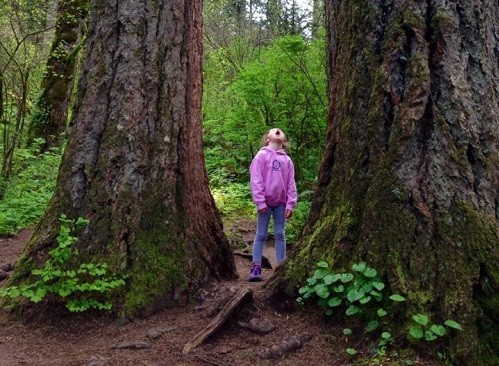
“There’s psychological value to old-growth,” she says. “There’s a love affair with old-growth. I don’t think you get the same feeling of majesty with other forests as you do with a climax forest.”
Defining Old-Growth
“The definition of ‘old-growth’ is somewhat complicated,” says Tim Coleman, director of the Columbia Highlands Initiative for Conservation Northwest. He also serves as Board secretary for the Northeast Washington Forestry Coalition. “The Coalition is currently grappling with this issue, because the science isn’t exactly clear. There is a size class, which is more of what animals need. So, it doesn’t matter how old they are; if they’re more than 20 inches in diameter, they’re important for the forest,” he says.
Age is also important, and a tree that’s 150 years old has genetics that make it superior, says Coleman-it’s a survivor. In general, any tree that old is considered old-growth, but “the U.S. Forest Service and science are [now] looking at definitions that include an ‘either/or’ statement,” he says. Yet, “diameter isn’t always an indicator of how old a tree is,” says Spicker. “I’ve seen trees be 12 inches in diameter and be 150 years old.”
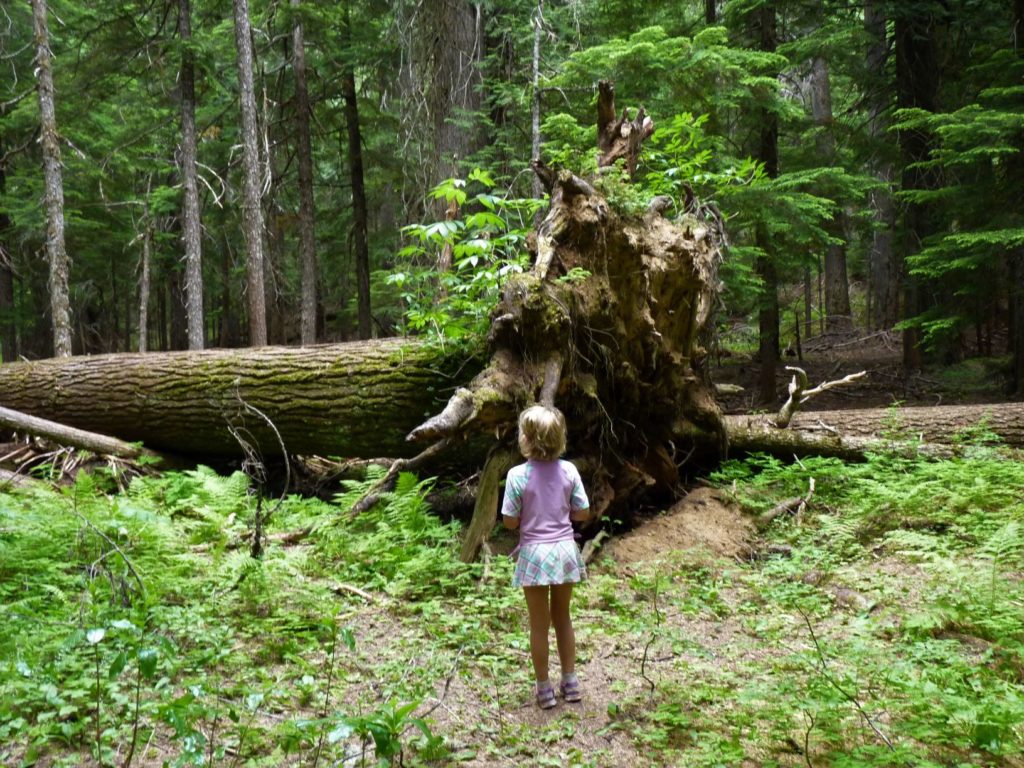
What usually isn’t disputed is an old-growth tree’s majesty and grandeur and the forest’s unique biodiversity, but having a common definition is just as vital as understanding the diverging perspectives of conservationists, landowners, the U.S. Forest Service and the timber industry.
“It’s important to understand what old-growth is and what it isn’t,” says Spicker. “Old-growth is a life stage, so what it is looks different according to the type of trees and the type of climate, soils, and topography. What takes 100 years to grow here can grow on the Washington coast in 40 years.” This slower growth in Eastern Washington is due to a thin soil level (thanks to the Great Missoula Floods), low moisture, and a short growing season.
A forest stand’s life cycle starts with a large disturbance that happens every 300-400 years. “All forests are products of prior disturbance , whether by volcano, flood, or human-caused disturbance,” Spicker says. After such an event, pioneer species such as longpole pine, fireweed, brush and ponderosa pine begin to grow — the stem initiation phase. The second stage of a forest is when these tree and plant species start competing with one other. “The brush gets shaded out, called stem exclusion. And that exclusion creates openings, but those are partially shaded by the trees that didn’t get excluded,” Spicker explains.
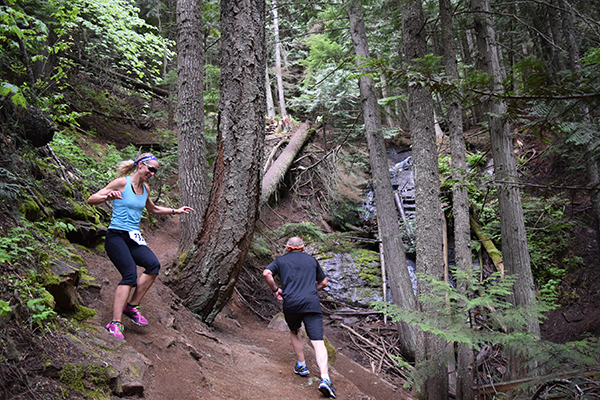
Next is the stem re-initiation stage when shade-tolerant trees-such as Douglas-fir, grand fir, hemlock and cedar-grow in these openings and become the forest overstory. Then comes the climax, or shifting mosaic, stage, “when small disturbances create new openings where new shade-tolerant trees come in,” says Spicker. “It looks like things are stable, but they’re not. When that stage lasts long enough, where enough overstory trees become terminal age for their species, that is old growth. It has nothing to do with virgin trees. A lot of people think it means ‘never been cut,’ but it has to do with the age of the tree.”
Therefore, to identify an old-growth grove, it’s important to know the tree species, the normal disturbance cycle, and the ecology (climate) to determine what old-growth really is; it’s not the same everywhere. In short, “Old-growth is a stage of climax, called ‘late successional,'” says Spicker.
Old-Growth In Progress
There is also “old-growth in the making,” Spicker says. “On the drive to Mount Spokane at the big switchback where you can park, the forest to the left is the classic combination: nearly completely canopied; downed trees, caused by wind, root rot, winter damage, or any number of reasons; and hardly anything is growing on the ground, except where something might have fallen over and there’s some green. This is classic climax. If you let that stand go long enough, and it doesn’t burn or the wind doesn’t take it out, it will become old-growth.” Because there has been fire through there, Spicker says the current trees are only 80 to 110 years old.
Indeed, a forest is “an aging community and eventually Mother Nature likes to clean house and start over again,” says Spicker, which leads to the controversial topic of fire suppression. “It isn’t necessarily good to prevent [fire] from happening — so much of the landscape is out of kilter anyway. Envision this mosaic of trees that have reached climax, that have reached old-growth. Those pockets of trees will shift around. [Tree] communities go through life stages, too, and an old-growth stand will eventually be disturbed and start over again — it’s waiting for that.”
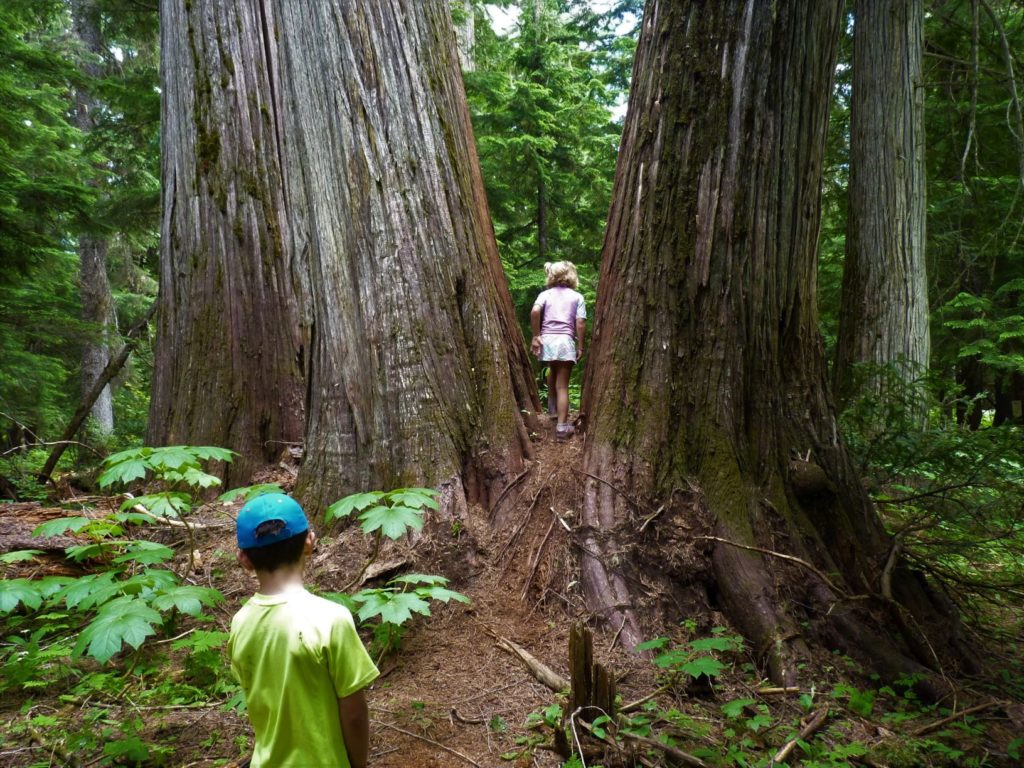
On the east side of the Cascades, she says, “If man wasn’t messing around, it would be more typical to see fire at a 7 to 15 year cycle. Those fires would be very mild and would kill a lot of the really tiny trees and freshen up the brush. And only the very tallest trees would survive, and there wouldn’t be very many of them — creating the park-like stands.” Meanwhile, on the west side of the Cascades, she says fire at 300-year intervals would be normal forest disturbance, if humans did not interfere. Mother Nature, however, doesn’t work as fast as the timber companies, who have a history of logging old-growth stands in the Northwest faster than new ones can be created.
Biodiversity of Old-Growth Forest
“Each forest stand stage supplies something different to the entire landscape, so they each have to be there in a reasonable balance,” Spicker says. But the old-growth area also needs to be large enough. The “edge effect” refers to the boundary area of old-growth that is affected by the adjacent forest community.
“Some of these [old-growth] patches aren’t big enough, so they look old but they don’t act old,” she says. “They’re getting too much sun or heat and not getting the true interior old-growth habitat.” Moreover, the grove is not big enough to support the animals that require this unique and complicated ecosystem.
Because it’s not just about big, old trees. An old-growth grove, Spicker explains, has specific components, including standing dead material. “There’s much more dead debris in old-growth than in younger [tree] stands; we call that ‘structure’-trees that are hollow and a canopy has developed around ecosystems,” says Spicker. “Any tree is mostly dead; the only things living are the needles and the cambium layer under the bark (responsible for tree diameter increases). The amount of standing dead material and trees with very slow growth are really important habitat for a lot of critters.
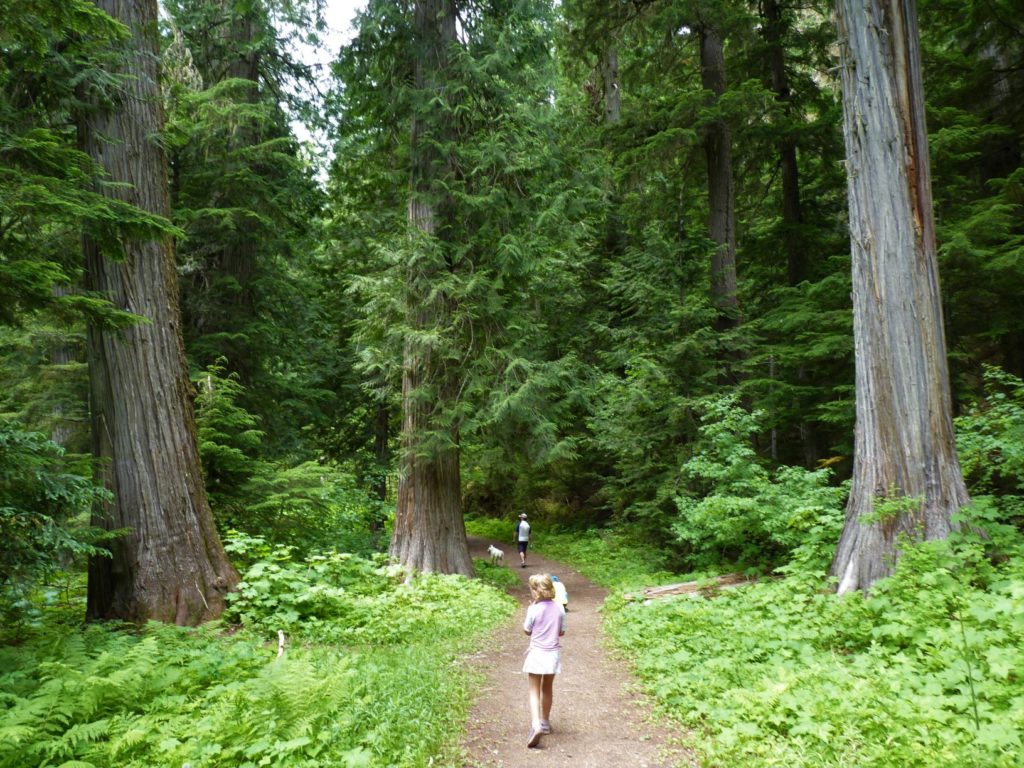
“Certainly, there are a whole bunch of animals that are dependent on it, but there are only a few that can only live in old-growth. You’d never want a landscape to be all old-growth, because there are animals that need the other stages, like deer, elk, and moose. Some animals might hide and live in old-growth but need the other stages for their food needs.” For example, the endangered northern spotted owl needs to have a climax stage forest for nesting, but it needs the first two, younger forest stages for hunting mice, according to Spicker. Proximity to old-growth is also vital for the owl’s protection from its primary predator, the northern goshawk. The standing snags, big trees, and complex forest canopy of old-growth provide this.
“The bio-diversity within old growth stands is much higher [than other forest stages],” says Spicker. Plants, fungi and lichen are more common in old-growth, and amphibians depend on it for their habitat. In fact, Spicker says that “18 of 62 amphibians are associated with late-successional” forests. In addition, 11 species of bats and 15 other mammal species prefer old-growth habitat, although are not totally dependent on it. Cavity nesters, like bats, need the snags; flying squirrels need the warmth provided by the forest canopy; bears use big, hollow trees as their dens; and 38 species of birds, including the northern spotted owl and marble murrelet (which lives near the coast), all require old-growth habitat for their survival.
If you’d like to exercise your own love affair with old-growth, here are some of the last remaining groves in the Inland Northwest:
Liberty Lake Loop Trail:
- Description: Passes through a grove of old-growth cedars.
- Location: Liberty Lake County Park, a Conservation Futures property purchased in 1993 for the Spokane County (Wash.) park system.
- Trail: Liberty Lake Loop Trail, two miles to the old-growth cedar grove (also a walk-in picnic area); loop is 7.5 miles round trip, easy to moderately difficult.
- Directions: I-90, Liberty Lake exit – head east on Appleway to Molter, south to Valleyway, east to Zephyr.
- Camping: Tent and RV camping sites at the park. More info: http://www.spokanecounty.org.
Ross Creek Cedar Groves:
- Description: a 100-acre grove dominated by 500-year-old giant western redcedars, some as big as eight feet in diameter and up to 175 feet tall.
- Location: Ross Creek Scenic Area – Kootenai National Forest, south of Troy, Montana.
- Trail: 0.9 mile paved trail with informational signs and benches along the route.
- Directions: From Troy, travel west three miles on U.S. Highway 2. Turn onto Montana Highway 56 and travel 21 miles. Turn right onto Ross Creek Road 398 and follow for four miles. The turnoff to the Ross Creek Cedars is one-half mile past the south end of Bull Lake off Montana Highway 56 – known locally as the Bull Lake Road. A four-mile long, paved windy road climbs to the parking area.
- Camping: Bad Medicine Campground at Bull Lake. More info: http://www.libbymt.com/areaattractions/rosscreekcedars.htm.
Hobo Cedar Grove Trail:
- Description: Old-growth cedar in St. Joe National Forest, part of the Idaho Panhandle National Forests.
- Location: Idaho Panhandle National Forest, St. Joe Ranger District.
- Trail: Hobo Cedar Grove Trail (#255), easy one mile (round-trip).
- Directions: From Clarkia, Idaho, follow Forest Road 301 to Forest Road 321 and then take Forest Road 3357 to the trailhead. Or from St. Maries, Idaho, follow Forest Highway 50 to Forest Road 321 at Marble Creek, and follow this to Forest Road 3357, which goes to the trailhead.
- Camping: Various campgrounds in the St. Joe National Forest, including Emerald Creek Campground near Fernwood, Idaho. More info: http://www.fs.fed.us/ipnf/rec/activities/trails/szhobocedar255.html.
DeVoto Memorial Cedar Grove:
- Description: Old-growth western redcedar trees, 1,200 to 3,000 years old.
- Location: Clearwater National Forest – Lolo Pass, Idaho.
- Trails: Two short looped trails – Trail of Discovery, on the eastern side of the road, is a paved, wheelchair-accessible interpretive trail that loops past Crooked Fork Creek.
- Directions: Off U.S. Highway 12, east of Powell, ID, near the top of Lolo Pass (Idaho side).
- Camping: Five campgrounds within the Powell Ranger District (12 miles west of Lolo Pass) – Jerry Johnson, Powell, Wendover, White Sand and Whitehouse campgrounds. More info: http://www.fs.fed.us/r1/lewisclark/lcic/grasslands/lolo_hwy12.html.
Roosevelt Grove of Ancient Cedars:
- Description: 24 acres of old-growth ranging from 800 to 2,000+ years, up to 12 feet in diameter and 150 feet tall.
- Location: Idaho Panhandle National Forest, Priest Lake Ranger District – off the road to Upper Priest Falls.
- Trails: Two options – (1) Granite Falls Trail #301 (and Stagger Inn Picnic Area) includes an easy trail along the creek (365 feet) and a one-mile loop trail from the lower cedar grove (two acres) to vista points above 612-foot Lower Granite Falls; continue 0.5 mile to upper cedar grove (20 acres); (2) Roosevelt Trail #266, 4.5 miles, more difficult, ascends a hill with switchbacks to another stand of old-growth cedar.
- Directions: From Highway 57, go approx. 14 miles north of Nordman to Forest Road 302.
- Camping: Beaver Creek Campground and many others, Priest Lake Ranger District. More info: http://www.fs.fed.us/ipnf/visit/brochures/priestlake/plrooseveltgrove.pdf.
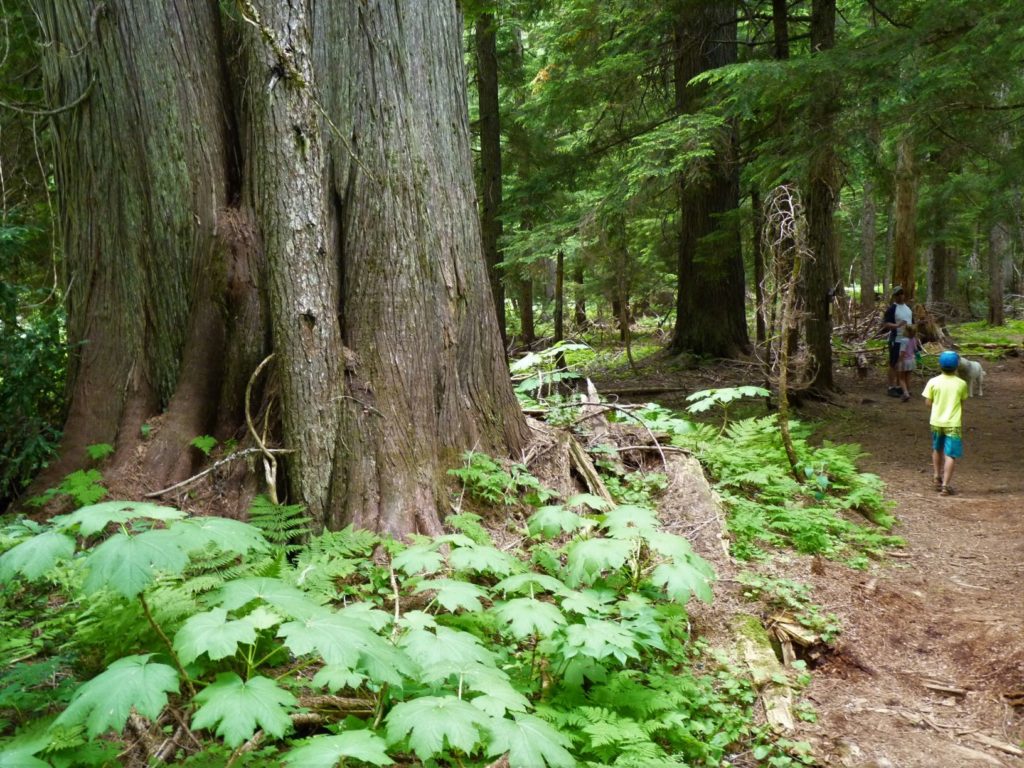
Hanna Flats Cedar Grove:
- Description: 16 acres of old-growth western white pine and western redcedars that are 200-800 years old, 3-6 feet across, 120-150 feet tall; survived the 1926 fire.
- Location: Idaho Panhandle National Forest, Priest Lake Ranger District.
- Trail: Easy .25 mile, family-friendly interpretative trail; trailhead is located one mile west of the Priest Lake Ranger Headquarters.
- Directions: From Priest River, go approx. 30 miles north on Highway 57, turn west onto Forest Road 313, and drive approx. 1.5 miles to the trailhead.
- Camping: Dickensheet Campground unit within Priest Lake State Park. More info: http://www.fs.fed.us/ipnf/visit/brochures/priestlake/plhannaflats.pdf.
Hoodoo Canyon:
- Description: Mixed old-growth forest in the Kettle Range of the Colville National Forest roadless area; north end is moist forest dominated by old-growth cedars, south end is dry/warm forest dominated by old-growth ponderosa pine.
- Location: Kettle Falls, Washington – Colville National Forest.
- Trail: Hoodoo Canyon Trail #17, 2.5 mile trail (one-way), easy, family-friendly route with a foot bridge over south fork of Deadman Creek and views of the Kettle Range and canyon; can also hike the steep trail to Emerald Lake (recommended for experience hikers only).
- Directions: From Kettle Falls, Wash., drive west on Highway 20 across the Columbia River and turn north onto Highway 395. Drive approx. 10 miles and turn west on Forest Road #460 (Deadman Creek Road). Go another 6 miles, turn left onto Forest Road 9565, and drive three miles to the trailhead and parking area on south side of road. (Most scenic route from Spokane, according to Tim Coleman, is to take Highway 2 to Wilbur, then Highway 21 north through the Sanpoil River Valley to Republic.)
- Camping: Trout Lake Campground or overnight backpacking at Emerald Lake. More info: http://www.fs.fed.us/r6/colville.
Thirteen Mile Canyon:
- Description: Groves of old-growth, predominately ponderosa pine.
- Location: Republic, Washington – Colville National Forest’s Thirteen Mile Roadless Area, just north of the Colville Indian Reservation.
- Trail: Thirteen Mile Trail #23, 16.5 miles; Thirteen Mile Creek from the Sanpoil River, approx. 6 miles.
- Directions: Access option #1: From Republic, follow Highway 20 to Forest Service Road 99 (Hall (Hall Creek Road) – very rugged, four wheel drive required; Access option #2: From Republic, travel state Route 21 south 13 miles to Thirteen Mile Trailhead campground.
- Camping: Thirteen Mile Campground. More info: http://www.fs.fed.us/r6/colville.
Ten Mile Trail:
- Description: Nice, easy hike through beautiful, mixed old growth forest that includes ponderosa pine, Douglass-fir and larch.
- Location: Republic, Washington – Colville National Forest.
- Trail: Ten Mile Trail #25, 2.5 miles, begins at Ten Mile Campground
- Directions: From Republic, Wash., go south on state Route 21 (Swan Lake Road) 10 miles to the Ten Mile Campground.
- Camping: Ten Mile Campground (includes a good beach for swimming in Swan Lake). More info: http://www.fs.fed.us/r6/colville.
Elk Creek Falls Trail:
- Description: Old-growth in the Selkirk Mountains in the proposed addition to the Salmo-Priest Wilderness Area.
- Location: East of Metaline Falls, WA, near Sullivan Lake – Colville National Forest.
- Trail: Elk Creek Trail #560, 2.1 mile loop trail to Elk Falls and the beach at Mill Pond.
- Directions: From Spokane, Wash., take Highway 2 toward Newport, turn northwest on Highway 211 and drive 15 miles to Usk and junction with Highway 20; turn northwest (left) on Highway 20 and drive 34 miles to the tiny town of Tiger and junction with Highway 31. Continue toward Ione about three miles on Highway 31. Just before Ione there is a turnoff on the right to Sullivan Lake (County Road 9345); follow this to Sullivan Lake, around the lakeshore, and continue past Mill Pond campground to Mill Creek Historical Site (FS 9345).
- Camping: Mill Pond Campground, Sullivan Ranger District – Colville National Forest. More info: http://www.fs.fed.us/r6/colville.
Virginia Lilly Old-Growth Trail
- Location: Okanogan Highlands, Okanogan National Forest, near Tonasket, Washington, in the Five Lakes area of the Tonasket Ranger District.
- Trail: Virginia Lilly Trail #322, more difficult 2-mile loop.
- Directions: From Tonasket, Wash., take State Route 20 east for 24 miles to Bonaparte Recreation Area exit on Okanogan County Road 4953, which turns into Forest Service Road 32. Bonaparte Lake Campground is six miles from State Route 20. Continue on FS Road 32 for two miles past Bonaparte Lake campground, then turn right on FS Road 3240 and drive six miles to the parking area.
- Camping: Bonaparte Lake Campground. More info: http://www.fs.fed.us/r6/oka/recreation/rog/virginia.html.
Big Tree Botanical Loop:
- Description: Old-growth ponderosa pine, Douglas-fir and Englemann spruce that are 300+ years old, and two 900-year-old western larches.
- Location: Okanogan National Forest, east of Tonasket, WA, near Bonaparte Lake
- Trail: Big Tree Trail #311, easy 0.7 mile loop
- Directions: From Tonasket, take State Route 20 east for 24 miles and turn north on Okanogan County Road 4935, which becomes Forest Service Road 32. Continue on FS Road 32 for 4 miles to FS Road 33. Turn left on FS Road 33-050 and go one mile to the campground entrance and trailhead starts across the road from the guard house.
- Camping: Lost Lake Campground. More info: http://www.fs.fed.us/r6/oka/recreation/rog/bigtree.html
Clackamas Mountain:
- Description: Mixed old-growth ponderosa pine, larch and Douglas-fir
- Location: Clackamas Mountain Roadless Area, six miles northwest of Republic on both the Colville and Okanogan National Forests.
- Trail: Approx. 8 miles, moderate difficulty with great views of the surrounding mountains and the Kettle Crest in the distance, trailhead begins at Sweat Creek Campground
- Directions: From Republic, go west on Highway 20 towards NF-3100000 and drive 8.6 miles to Sweat Creek Campground.
- Camping: Sweat Creek Campground, on Highway 20 between Republic and Tonasket (may not be maintained by the USFS); other campground options in the Okanogan and Wenatchee National Forests. More info: http://www.fs.fed.us/r6/oka
Denny Creek:
- Description: On the way to Seattle old-growth western hemlock, Pacific silver fir forest and western redcedar in between the two halves of I-90.
- Location: Cascade Mountains, Mount Baker-Snoqualmie National Forest (Snoqualmie Ranger District)
- Trail: Denny Creek Trail #1014, 4.4 miles one way, moderate difficulty
- Directions: From I-90, Denny Creek exit #47, turn right onto Denny Creek Road (Forest Road 58), then turn left in one-third of a mile. Stay on road for 2.3 miles and turn left onto Forest Road 5830 past the Denny Creek Campground. (Another option: Asahel Curtis Nature Trail and Picnic Area – take Forest Road 5590; one-mile trail loops through old-growth Douglas-fir and more on hillslope above I-90).
- Camping: Denny Creek Campground and limited backpacking campsites at Melakwa Lake (4.5 miles from trailhead, Melakwa Lake Trail #1011). More info: http://www.fs.fed.us/r6/mbs/recreation/activities/trails/snrd/snrd_1014.htm
Oregon’s Old-Growth Ponderosa Pine Forests:
- Description: Ponderosa pine can reach diameters over 100 inches at breast height and live 400+ years.
- Various Locations: Best old-growth ponderosa pine groves are in Central and Eastern Oregon, east of Cascade Range Crest – Gifford Pinchot National Forest (Mount Adams Ranger District), Mount Hood National Forest (Barlow Ranger District), Willamette National Forest (Middle Fork Ranger District)
- More info: http://www.fs.fed.us/pnw/forests/east-cascade/ponderosa-pine/mature/index.shtml
- Guidebook: Best Old-Growth Forest Hikes: Washington & Oregon Cascades by John and Dianne Cissel.
Old Growth Trail British Columbia, Canada
- Description: Cedar trees.
- Location: Kokanee Glacier Provincial Park in the Selkirk Mountains of B.C., Canada.
- Trail: 2 km loop, great for kids.
- Driving Directions: Halfway up the access road to Kokanee Glacier Park, northeast of Nelson, B.C.
- Camping: 30 wilderness, walk-in campsites in the park. More info: http://www.env.gov.bc.ca/bcparks/explore/parkpgs/kokangla.html.
Giant Cedars Boardwalk Trail British Columbia, Canada
- Description: Old-growth stand of western redcedar, some more than 800 years old.
- Location: Mount Revelstoke National Park in B.C., Canada.
- Trail: Begins at the Giant Cedars Picnic Area, 30 km east of Revelstoke on the Trans Canada Highway.
- Directions: Trans Canada Highway (Highway #1), just inside the park’s boundary for 13 km along the southeast perimeter of the park. More info: http://www.pc.gc.ca/pn-np/bc/revelstoke/activ/activ2_e.asp.
Protecting Old Growth
“There will be hearings later this summer, sometime in August and September, on the fate of the Colville National Forest roadless areas and facilitated by the Forest Service,” says Tim Coleman from Conservation Northwest and the Northeast Washington Forestry Coalition. “The future of these wild places will be decided by the Forest Service, and action from Congress can happen anytime. The Blueprint [proposal for managing the Colville National Forest] represents more than just the plan; it represents working with communities, problem-solving, fire risk and forest health issues, in addition to protecting big, old trees and wild places.” For more details, go to http://www.newforestrycoalition.org.
“Old growth forests are more than a bunch of giant, moss covered trees, spongy forest floor and speckles of sunlight poking through thick canopies,” say The Lands Council’s Executive Director Mike Petersen.” They are the homes of some of the rarest species in the United States. The mountain caribou, flammulated owl, Canadian lynx, northern goshawk and many others find their homes in these undisturbed forests.” The Lands Council has surveyed the old growth forests of North Idaho and found them fragmented, roaded and logged. While the Idaho Panhandle National Forest is only required to protect 10% of the forest as old growth, they found many of the stands they claimed were old growth were missing.
One timber sale in particular, the Mission Brush project northeast of Bonners Ferry is in contention. The Lands Council challenged the decision that would have logged old growth, supposedly to help rare species.
To learn more about Conversation Northwest’s work to protect old-growth forests and other wild areas from the Washington Coast to the BC Rockies, go to http://www.conservationnw.org/getinvolved.
To learn about The Lands Council and its Old Growth Forest Campaign, go tohttp://www.landscouncil.org/forests/old_growth.asp. There’s a link to a PDF of “Lost Forests: An Investigative Report on the Old-growth of North Idaho” by Ellen Picken, published in 2005 by The Lands Council.













